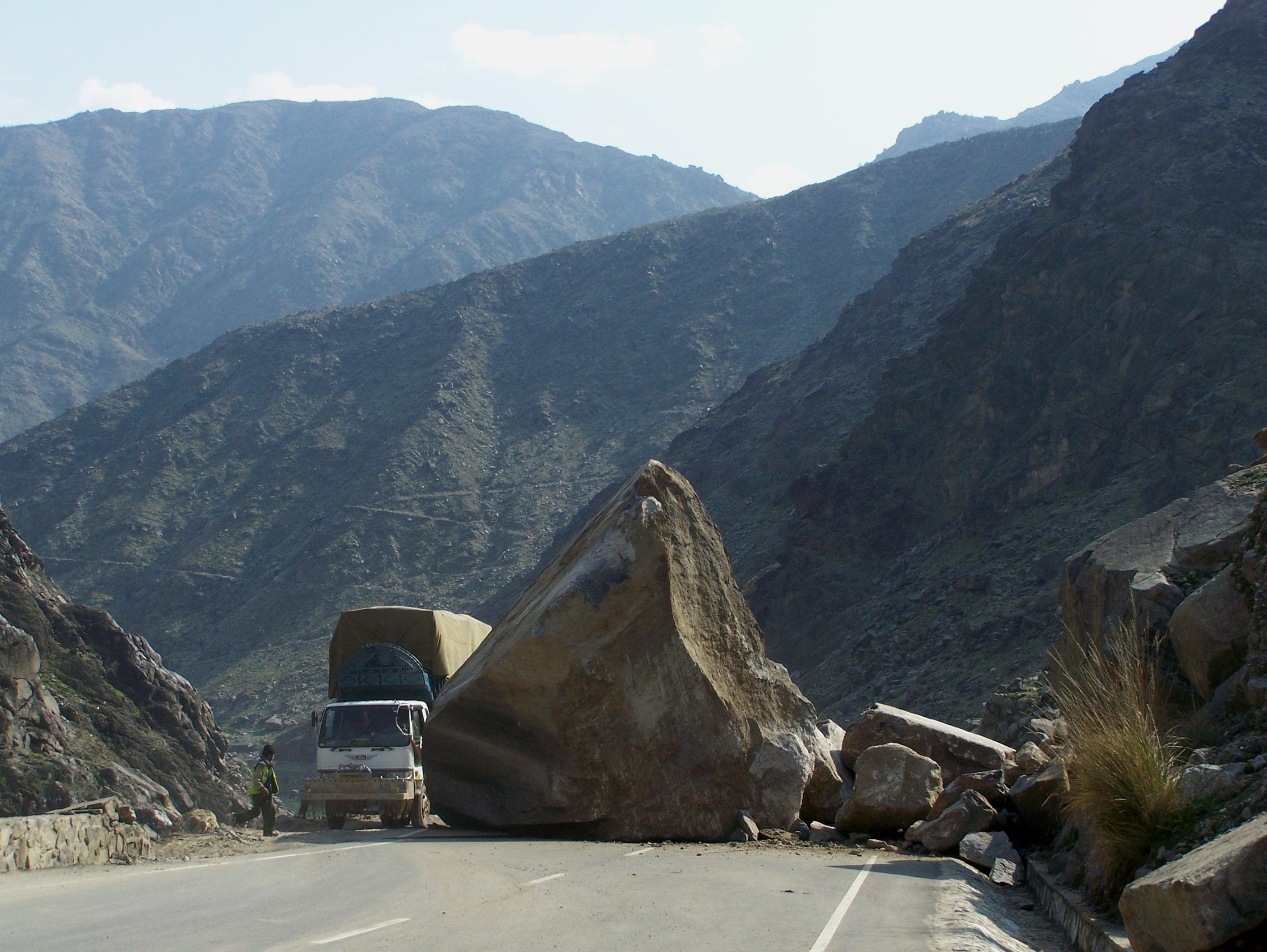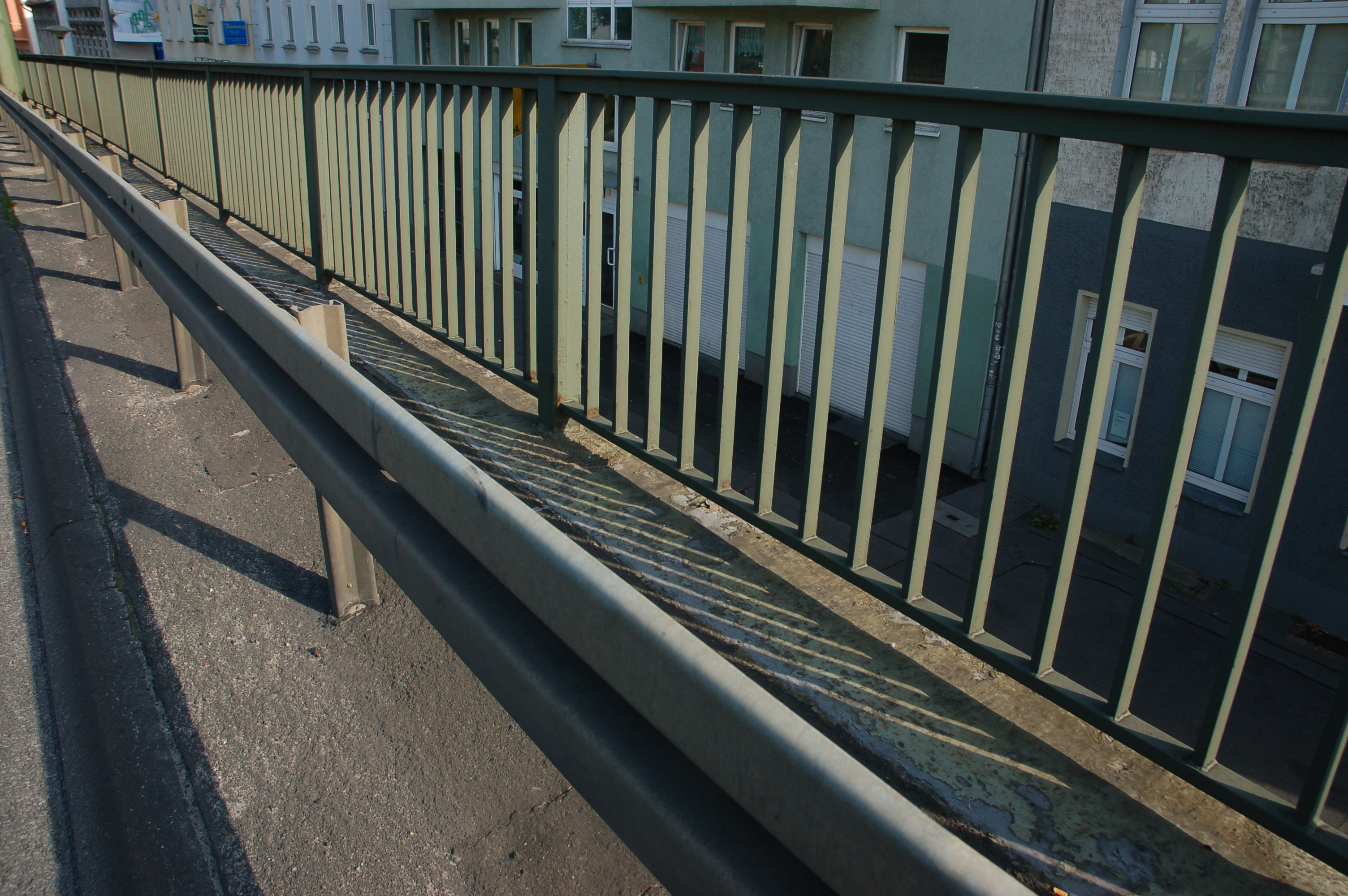|
Rockfall Protection Embankment
A rockfall protection embankment is an earthwork built in elevation with respect to the ground to intercept falling rock fragments before elements at risk such as roads and buildings are reached. This term is widely used in the rockfall community but the terms ''bunds'' and ''walls'' are sometimes used as alternatives. Comparison with other passive mitigation structures Rockfall protection embankments belong to the family of passive rockfall protection structures, comprising flexible barriers or galleries in particular. They are intended for rockfalls with kinetic energies up to tens of megajoules and are preferred over flexible barriers when the design impact is higher than 5000 kJ. Their declared advantages over other passive rockfall mitigation structures are low maintenance costs and reduced visual impact. Nevertheless, they are not appropriate on steep slopes and their construction generally requires extensive space and accessibility for heavy vehicles. History The very ... [...More Info...] [...Related Items...] OR: [Wikipedia] [Google] [Baidu] |
Megajoule
The joule ( , or ; symbol: J) is the unit of energy in the International System of Units (SI). In terms of SI base units, one joule corresponds to one kilogram- metre squared per second squared One joule is equal to the amount of work done when a force of one newton displaces a body through a distance of one metre in the direction of that force. It is also the energy dissipated as heat when an electric current of one ampere passes through a resistance of one ohm for one second. It is named after the English physicist James Prescott Joule (1818–1889). Definition According to the International Bureau of Weights and Measures the joule is defined as "the work done when the point of application of 1 MKS unit of force ewtonmoves a distance of 1 metre in the direction of the force." In terms of SI base units and in terms of SI derived units with special names, the joule is defined as One joule is also equivalent to any of the following: * The work required to move ... [...More Info...] [...Related Items...] OR: [Wikipedia] [Google] [Baidu] |
Geotextile
Geotextiles are versatile permeable fabrics that, when used in conjunction with soil, can effectively perform multiple functions, including separation, filtration, reinforcement, protection, and drainage. Typically crafted from polypropylene or polyester, geotextile fabrics are available in two primary forms: woven, which resembles traditional mail bag sacking, and nonwoven, which resembles felt. Geotextile composites have been introduced and products such as geogrids and meshes have been developed. Geotextiles are durable and are able to soften a fall. Overall, these materials are referred to as geosynthetics and each configuration—geonets, geosynthetic clay liners, geogrids, geotextile tubes, and others—can yield benefits in geotechnical engineering, geotechnical and environmental engineering design. History Geotextiles were originally intended to be a substitute for granular soil filters. Geotextiles can also be referred to as ''filter fabrics''. In the 1950s, R.J. Barr ... [...More Info...] [...Related Items...] OR: [Wikipedia] [Google] [Baidu] |
Geogrid
A geogrid is geosynthetic material used to reinforce soils and similar materials. Soils pull apart under tension. Compared to soil, geogrids are strong in tension. This fact allows them to transfer forces to a larger area of soil than would otherwise be the case. Geogrids are commonly made of polymer materials, such as polyester, polyvinyl alcohol, polyethylene or polypropylene. They may be woven or knitted from yarns, heat-welded from strips of material, or produced by punching a regular pattern of holes in sheets of material, then stretched into a grid. The development of methods of preparing relatively rigid polymeric materials by tensile drawing, in a sense "cold working," raised the possibility that such materials could be used in the reinforcement of soils for walls, steep slopes, roadway bases and foundation soils. The principal function of geogrids is for reinforcement. This area, as with many other geosynthetics, is very active, with a number of different products, m ... [...More Info...] [...Related Items...] OR: [Wikipedia] [Google] [Baidu] |
Gabion
A gabion (from Italian ''gabbione'' meaning "big cage"; from Italian ''gabbia'' and Latin ''cavea'' meaning "cage") is a cage, cylinder or box filled with rocks, concrete, or sometimes sand and soil for use in civil engineering, road building, military applications and landscaping. For erosion control, caged riprap is used. For dams or in foundation construction, cylindrical metal structures are used. In a military context, earth- or sand-filled gabions are used to protect sappers, infantry, and artillerymen from enemy fire. Leonardo da Vinci designed a type of gabion called a ''Corbeille Leonard'' ("Leonard basket") for the foundations of the San Marco Castle in Milan. Civil engineering The most common civil engineering use of gabions was refined and patented by Gaetano Maccaferri in the late 19th century in Sacerno, Emilia Romagna and used to stabilize shorelines, stream banks or slopes against erosion. Other uses include retaining walls, noise barriers, temporary fl ... [...More Info...] [...Related Items...] OR: [Wikipedia] [Google] [Baidu] |
Rockfall
A rockfall or rock-fallWhittow, John (1984). ''Dictionary of Physical Geography''. London: Penguin, 1984. . is a quantity of Rock (geology), rock that has fallen freely from a cliff face. The term is also used for collapse of rock from roof or walls of mine or quarry workings. A rockfall is "a fragment of rock (a block) detached by sliding, toppling, or falling, that falls along a vertical or sub-vertical cliff, proceeds down slope by bouncing and flying along ballistic trajectories or by rolling on talus or debris slopes". Alternatively, a rockfall is "the natural downward motion of a detached block or series of blocks with a small volume involving free falling, bouncing, rolling, and sliding". The mode of failure differs from that of a rockslide. Causal mechanisms Favourable geology and climate are the principal causal mechanisms of rockfall, factors that include intact condition of the rock mass, discontinuities within the rockmass, weathering susceptibility, ground and surfa ... [...More Info...] [...Related Items...] OR: [Wikipedia] [Google] [Baidu] |
Traffic Barrier
Traffic barriers (known in North America as guardrails or guard rails, in Britain as crash barriers, and in auto racing as Armco barriers AK Steel (formerly Armco) genericized trademark) keep vehicles within their roadway and prevent them from colliding with dangerous obstacles such as boulders, sign supports, trees, bridge abutments, buildings, walls, and large storm drains, or from traversing steep (non-recoverable) slopes or entering deep water. They are also installed within medians of divided highways to prevent errant vehicles from entering the opposing carriageway of traffic and help to reduce head-on collisions. Some of these barriers, designed to be struck from either side, are called median barriers. Traffic barriers can also be used to protect vulnerable areas like school yards, pedestrian zones, and fuel tanks from errant vehicles. In pedestrian zones, like school yards, they also prevent children or other pedestrians from running onto the road. While barriers are no ... [...More Info...] [...Related Items...] OR: [Wikipedia] [Google] [Baidu] |
Road Infrastructure
A road is a thoroughfare used primarily for movement of traffic. Roads differ from streets, whose primary use is local access. They also differ from stroads, which combine the features of streets and roads. Most modern roads are paved. The words "road" and "street" are commonly considered to be interchangeable, but the distinction is important in urban design. There are many types of roads, including parkways, avenues, controlled-access highways (freeways, motorways, and expressways), tollways, interstates, highways, and local roads. The primary features of roads include lanes, sidewalks (pavement), roadways (carriageways), medians, shoulders, verges, bike paths (cycle paths), and shared-use paths. Definitions Historically, many roads were simply recognizable routes without any formal construction or some maintenance. The Organization for Economic Co-operation and Development (OECD) defines a road as "a line of communication (travelled way) using a stabilized base o ... [...More Info...] [...Related Items...] OR: [Wikipedia] [Google] [Baidu] |
Protective Barriers
A separation barrier or separation wall is a barrier, wall or fence, constructed to limit the movement of people across a certain line or border, or to separate peoples or cultures. A separation barrier that runs along an internationally recognized border is known as a border barrier. David Henley opines in ''The Guardian'' that separation barriers are being built at a record-rate around the world along borders and do not only surround dictatorships or pariah states. In 2014, The ''Washington Post'' listed notable 14 separation walls as of 2011, indicating that the total concurrent number of walls and barriers which separate countries and territories is 45. The term "separation barrier" has been applied to structures erected in Belfast, Homs, the West Bank, São Paulo, Cyprus, and along the Greece-Turkey border and the Mexico-United States border. In 2016, Julia Sonnevend listed in her book ''Stories Without Borders: The Berlin Wall and the Making of a Global Iconic Event'' ... [...More Info...] [...Related Items...] OR: [Wikipedia] [Google] [Baidu] |






